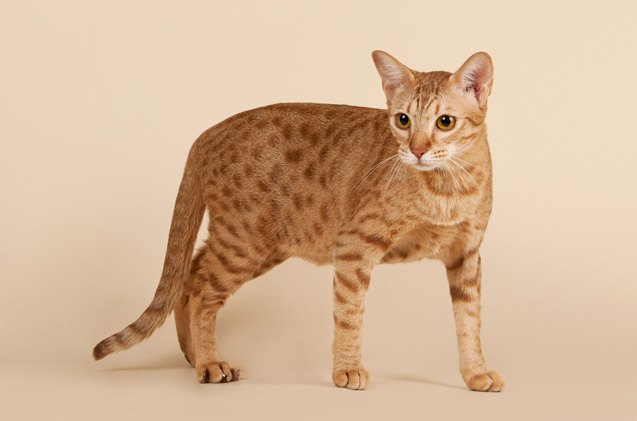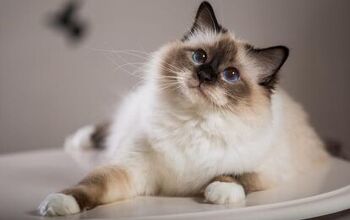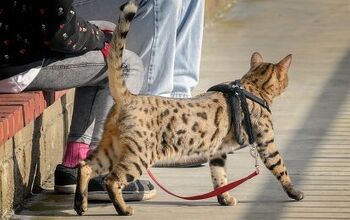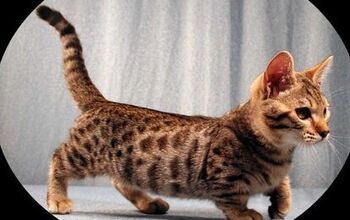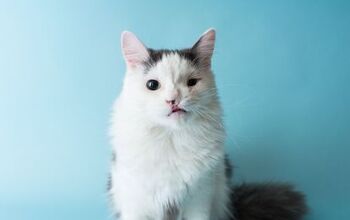Ocicat


About Ocicat
The spotted Ocicat is the result of interbreeding the Abyssinian, Siamese, and American Shorthair. It is a completely domestic cat, with no wild blood in its heritage. As such, it is the only spotted domestic cat bred to look like its wild cousins including the Ocelot from whom its name is derived as an homage. The first Ocicat, which was born in 1964, was an accident. The goal was to create an Abypoint Siamese and instead a beautiful spotted male named Tonga was born. He was neutered and sold as a pet, but when noted geneticist Dr. Clyde Keeler expressed enthusiasm for a domestic spotted cat, the breeding was repeated and the Ocicat line truly began. They were recognized for CFA registration in 1966, and advanced to championship status in May 1987.
Neither a demanding or clingy cat, the Ocicat loves to be with his humans as much as possible and isn’t above nudging you for a bit of attention.
There is nothing “wild” about the temperament of the loyal and devoted Ocicat. Neither a demanding or clingy cat, the Ocicat loves to be with his humans as much as possible and isn’t above nudging you for a bit of attention. They are unusually sensitive cats, and can show a strong response to being scolded, actually exhibiting a very dog-like shame for being in “trouble.” They are also receptive to being taught to fetch, sit, heel, and lie down on command, and they are quite agreeable to walking on a leash. They do well with children and other pets, but they don’t like to be left alone for long periods of time. They have a distinctive and happy purr, which they use often and generously, and they are great talkers after the fashion of their Siamese ancestors. Most owners report their Ocicats will actively engage in conversation, answering and commenting with great sincerity, and even following from room to room to get the last word. Since they are highly agile cats, it’s not unusual to find an Ocicat peering down at you from the highest spot in any room.
The Ocicat is a big, active athletic animal with a long, elegant body. This solid, well-muscled cat has a short, tight coat that gleams over its well-developed body showing off the elegant spots to their best advantage. Large, pointed ears top their triangular faces and almond eyes stare out with an open, interested expression. An Ocicat’s spots run in rows along his spine from the shoulders to the tail, and are then scattered over the body and down the legs. The spots on the torso are roughly the size of a thumbprint. Most resemble a classic “bull’s eye” pattern.
The Ocicat is available in 12 colors and four patterns: ticked, classic tabby, solid, and pointed. Colors include tawny, chocolate, cinnamon, blue, lavender and fawn, and black. Each of those six colors can also be mixed with silver to create the full coat range.
Since the Ocicat has such a short, dense coat, he is an extremely low maintenance cat. Most owners simply rub them down once a week or so with a chamois cloth to remove dead hairs and to keep their coats gleaming.
Photo credit: dien/Shutterstock

Amy Tokic, Editor of PetGuide.com, is a passionate animal lover and proud pet parent of Oscar, a Shih Tzu/Chihuahua cross, and Zed, a Japanese Chin. Her love of animals began in kindergarten, when she brought her stuffed dog Snoopy into class with her every day. Now, she writes about her adventures in pet ownership and tirelessly researches products, news and health related issues she can share with other animal enthusiasts. In her free time, Amy loves perusing used book and record stores, obsessing over the latest pet products available and chasing squirrels with wild abandon (a habit attributed to spending too much time with her pooches).
More by Amy Tokic



